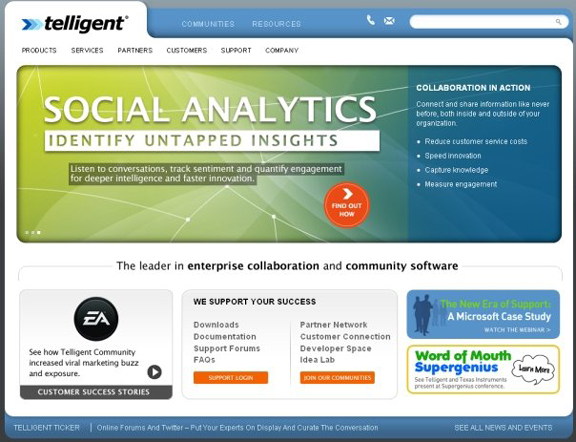Latest News
February 16, 2010
On Thursday February 10, Gary Hamel, the man The Wall Street Journal called “the world’s most influential business thinker” and Fortune called “the world’s leading expert on business strategy,” spoke to a captive audience in the ballroom in Santa Clara Marriott, the site of this year’s Microsoft Global High Tech Summit. Before his talk was over, an excerpt from his speech began traveling through Twitter.
For those under 30, the web is their life operating system.
The initial message, or Tweet, might have come from a single flickering Blackberry or an iPhone within the hotel, but once unleashed, Hamel’s nugget of wisdom got broadcast over and over, reverberating throughout the event’s Twitter stream (#hightech10) like an echo.
According to Microsoft’s instant poll, 63.9% of the audience believe the high tech market has begun its recovery. Many of them came to hear about the “big ideas” from their peers, to “[accelerate] through the turn,” as the event’s theme suggests. One of the big ideas is to embrace social computing, to learn from popular apps like Facebook, Twitter, and YouTube to deal with something enterprise apps have largely failed to tackle: sentiments and emotions from collaborators, employees, and customers.
Keeping Your Customers’ Emotions in Check
Drew Gude, Microsoft’s director of U.S. High Tech and Electronics Manufacturing Industry Solutions, observed, “Many high-tech manufacturers have already adopted business-to-consumer social computing channels due to the explosion of sites like Facebook. The consumer practice of sharing information through social interaction has opened the door for a handful of manufacturers to examine the use of social computing tools in a business-to-business capacity” (“Unstructured Collaboration is Key to Increased Innovation and Business Agility in 2010,” Microsoft Resource Library).
Rob Howard, founder and CTO of Telligent, figured this out before his peers did, allowing him to build a series of web-based software platforms—Telligent Enterprise, Telligent Community, Telligent Analytics—for businesses that want to add Facebook-like features, Wikipedia-style content, blogs, forums, and user-ratings into their internal or public sites.
Building and maintaining a media-rich, interactive customer portal is one thing; extracting useful information out of its online traffics and noises is quite another. How does a business, for example, single out users who contribute the most, identify topics that produce the greatest reaction, and figure out the percentage of comments that are negative or positive?
“We hired some smart people to write a language-parsing engine for us,” revealed Howard. “It takes sentence structures, breaks them down, and looks at positive and negative use of certain words, and how they reflect on the nouns ... It can’t recognize use of sarcasm, irony, or other [unorthodox] use of language, but in working with a large volume of data, [the engine] can be about 80% accurate.”
The natural language engine is proprietary and currently supports only English, he explained. This method lets Telligent customers extract from their communities not just statistical data (this week, topic A generates 50 comments in the forum) but consumer sentiments as well (of all the comments associated with topic A in the last three months, 60% express negative sentiments).
The customer list for Howard’s company includes high-traffic online communities representing Microsoft, Dell, Procter & Gamble, EA Sports, MSNBC, and other name brands. Telligent Enterprise is for internal communities (such as a corporate-wide networking site); Telligent Communities is for public portals (such as user communities for a certain product or brand); Telligent Analytics provides insights culled from user interactions.
You don’t have to be a Procter & Gamble-size giant to use Telligent, Howard pointed out. “It’s ideal for mid-size companies, perhaps 100+ employees dispersed globally.”
As can be expected of a social computing pioneer, Telligent reaches out to customers via Facebook, Twitter, and YouTube.

Insights from Unstructured Data
Bob Parker, a group VP of IDC Manufacturing Insights, outlined a hypothetical scenario, derived from the costly mistakes he’s witnessed in his research. An engineer put a regulator into the design, because he discovered that the battery tended to overheat. but in the next design cycle, someone else removed the regulator to save $0.15 from the bill of materials.
Peter Gosbee, Emerson’s global co-lead for Product Lifecycle Management (PLM) Center of Excellence, noted, “PLM system is a formalized way to capture the whys—the reasons [for a design to be the way it is]—so you don’t end up repeating history ... but as you start to capture these data, you end up with lots of information, data overload.”
PLM is well-equipped to house supplier contacts, part numbers, cost estimates, price quotes, and other manufacturing-related details but not ideal for concepts that emerge from a brainstorming session or a series of customer complaints that reveal a serious design flaw. To fill this gap, some PLM advocates are turning to social computing.
PTC, an exhibitor at the summit, was promoting Windchill ProductPoint, built on Microsoft SharePoint platform. The product uses “social networking technologies and associated Web 2.0 services for business-related purposes—and product development activities,” the company explains. (For more, read “PTC User World Event 2009: PTC Windchill Gets More Social,“June 11, 2009.)
Dassault Systemes, another exhibitor at the summit and a competitor to PTC, recently unveiled plans to introduce web-based professional networking features to users of its mid-range mechanical CAD program SolidWorks. (For more, read “SolidWorks World 2010, Part Two: SolidWorks PLM, by way of 3DVIA and ENOVIA,” Feb 4, 2010.)
With more social networking features incorporated, PLM systems can accommodate something they previously couldn’t: crowd sourcing. By engaging with customers and end users through online communities, manufacturers can enlist them to become collaborators in the product development process.
In addition to generating goodwill (customers like companies that listen to their grievances), crowd sourcing also offers incredible savings: Unlike consultants, customers don’t charge you for their input.
Subscribe to our FREE magazine, FREE email newsletters or both!
Latest News
About the Author
Kenneth Wong is Digital Engineering’s resident blogger and senior editor. Email him at [email protected] or share your thoughts on this article at digitaleng.news/facebook.
Follow DE





